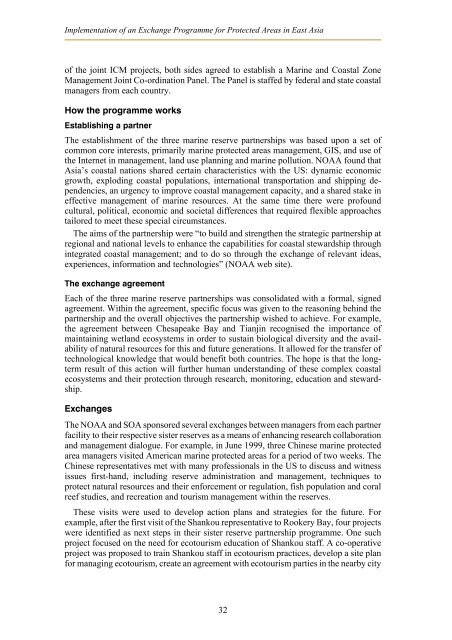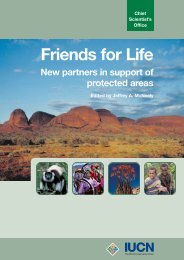Exchange programmes - IUCN
Exchange programmes - IUCN
Exchange programmes - IUCN
Create successful ePaper yourself
Turn your PDF publications into a flip-book with our unique Google optimized e-Paper software.
Implementation of an <strong>Exchange</strong> Programme for Protected Areas in East Asia<br />
of the joint ICM projects, both sides agreed to establish a Marine and Coastal Zone<br />
Management Joint Co-ordination Panel. The Panel is staffed by federal and state coastal<br />
managers from each country.<br />
How the programme works<br />
Establishing a partner<br />
The establishment of the three marine reserve partnerships was based upon a set of<br />
common core interests, primarily marine protected areas management, GIS, and use of<br />
the Internet in management, land use planning and marine pollution. NOAA found that<br />
Asia’s coastal nations shared certain characteristics with the US: dynamic economic<br />
growth, exploding coastal populations, international transportation and shipping dependencies,<br />
an urgency to improve coastal management capacity, and a shared stake in<br />
effective management of marine resources. At the same time there were profound<br />
cultural, political, economic and societal differences that required flexible approaches<br />
tailored to meet these special circumstances.<br />
The aims of the partnership were “to build and strengthen the strategic partnership at<br />
regional and national levels to enhance the capabilities for coastal stewardship through<br />
integrated coastal management; and to do so through the exchange of relevant ideas,<br />
experiences, information and technologies” (NOAA web site).<br />
The exchange agreement<br />
Each of the three marine reserve partnerships was consolidated with a formal, signed<br />
agreement. Within the agreement, specific focus was given to the reasoning behind the<br />
partnership and the overall objectives the partnership wished to achieve. For example,<br />
the agreement between Chesapeake Bay and Tianjin recognised the importance of<br />
maintainingwetland ecosystems in order to sustain biological diversity and the availability<br />
of natural resources for this and future generations. It allowed for the transfer of<br />
technological knowledge that would benefit both countries. The hope is that the longterm<br />
result of this action will further human understandingof these complex coastal<br />
ecosystems and their protection through research, monitoring, education and stewardship.<br />
<strong>Exchange</strong>s<br />
The NOAA and SOA sponsored several exchanges between managers from each partner<br />
facility to their respective sister reserves as a means of enhancingresearch collaboration<br />
and management dialogue. For example, in June 1999, three Chinese marine protected<br />
area managers visited American marine protected areas for a period of two weeks. The<br />
Chinese representatives met with many professionals in the US to discuss and witness<br />
issues first-hand, includingreserve administration and management, techniques to<br />
protect natural resources and their enforcement or regulation, fish population and coral<br />
reef studies, and recreation and tourism management within the reserves.<br />
These visits were used to develop action plans and strategies for the future. For<br />
example, after the first visit of the Shankou representative to Rookery Bay, four projects<br />
were identified as next steps in their sister reserve partnership programme. One such<br />
project focused on the need for ecotourism education of Shankou staff. A co-operative<br />
project was proposed to train Shankou staff in ecotourism practices, develop a site plan<br />
for managing ecotourism, create an agreement with ecotourism parties in the nearby city<br />
32






